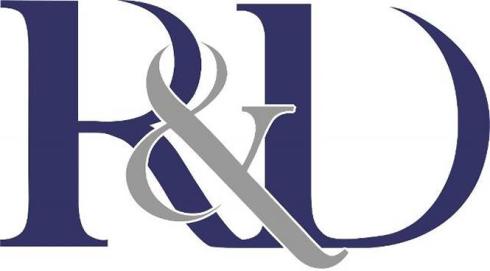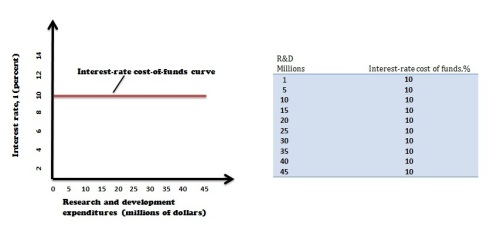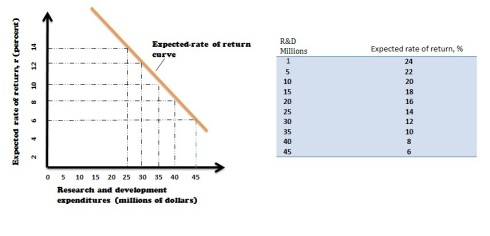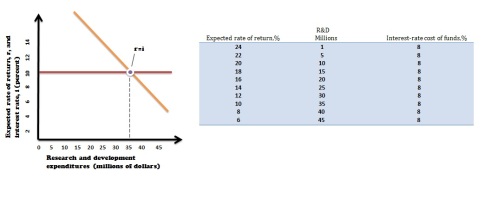
How do firms decide what amount of research and development to use? This depends on the amount of marginal benefit and marginal cost firm gets after R&D activity. This decision comes from one basic rule of economics: In order to get the greatest profit a firm should expand a specific activity until marginal benefit (MB) will be equal to its marginal costs (MC). If a firm sees that a R&D activity brings more marginal benefit than the marginal cost then this firm should expand its activity. However, if marginal benefit is less than marginal cost then this R&D activity should stop or shouldn?t be started. R&D spending decisions is a complex one, because it involves a possible future gain for present sacrifice. While R&D spending is immediate the expected benefits are uncertain and may occur at some possible future point in time. The MB=MC idea is still relevant for R&D decisions.
Spending in R&D
In order to obtain funds for R&D activities firms have several options:
? Bank loans- Some firms are able to finance their R&D activities by obtaining loans from banks or other type of financial institutions. The cost of using this kind of funds is the interest rate paid to the lender. The marginal cost is the Future Value (FV) of money borrowed.
Bonds- Profitable firms may borrow funds for R&D by issuing bonds and selling them. In this case, interest is the cost paid by bondholders to lenders. In this case, again, marginal cost is the interest rate paid for money borrowed.
Retained earnings- some big firms may finance their R&D activity by retaining some earnings. In this case firm retains a part of its profit rather than paying dividends to its owners. Some undistributed corporate profit, called retained earnings, can be used to finance R&D activity. The marginal cost in this case is the rate that could be earned from interest as deposits in financial institutions.
Venture capital- A small start-up firm may be able to attract venture capital to attract R&D projects. Venture capital is simply money, not real capital. Venture capital is part of household savings that is used to finance high-risk business venture in exchange of possible future share if thus ventures succeed. Marginal cost of this type of financing is the share of expected profit that business will have to pay to these people that offered this money.
Personal savings- Sometimes entrepreneurs may finance R&D activities from their own savings. In this case marginal cost is the forgone interest rate.
To sum up, we may state that whatever are the funds for R&D, the marginal cost in all the cases is forgone interest rate, i. Let?s assume that interest rate is the same for all amount of money needed. Also, let?s say that a firm call EcoMoney must pay an interest rate of 10% for the least expensive funding available to it. Let?s draw a graph called interest-rate cost-of-funds curve that denotes marginal cost of each amount of money borrowed for 10% interest rate and is shown simply by a horizontal line. Let?s make a graph and a table that depicts this situation.
With this information EcoMoney want to determine how much R&D to finance in the next year.
Expected Rate of Return
Firm?s marginal benefit from each dollar spent on R&D is it is profit (or return) gained from it. Thus R&D is expected to result in a new product or production method that will increase firm?s revenue. This return isn?t guaranteed but it is possible, so there is a risk to invest money in research and development process. Let?s suppose that after considering all risks EcoMoney constructs an expected-rate of return versus research and development cost graph and table. Expected-rate of return curve is marginal benefit of each dollar spent on R&D. This curve slope is negative because of diminishing returns from R&D expenditures. A firm will direct its initial R&D expenditures to the highest expected-rate of return activities and additional funding will be invested in activities that offer successively lower rates of returns. Thus firm increases R&D spending it uses to finance R&D activities of progressively lower rates of returns.
Optimal R&D spending
The figure bellow combines interest-rate-cost-of-funds curve and the expected rate of return curve. These two curves intersect at EcoMoney?s optimal amount of R&D, which is 35 million of dollars. This result can also be determined from the previous tables that showed amount of funding at various rates of return and interest cost of borrowing (in this case 10%). AT this point MR and MC from expenditures on R&D are equal. The firm should undertake all R&D expenditures up to 35 million of dollars, since these parameters yield higher marginal benefit and expected rate of return, r, than interest costs of borrowing money, i.
Optimal vs. affordable R&D
As we know there can be too much, or too little of a good thing. So it is with R&D and technological advance. The figures from above show that R&D expenditures make sense as long as the expected return equals or exceeds the expenditures needed to finance it. Many R&D expenditures may be affordable but also most of them aren?t worthwhile, because their marginal benefit is less than their marginal cost.
Not Guaranteed returns
??? The outcome of R&D researches are expected, but not guaranteed. At the time of decision, it may look worthwhile, but they can?t predict with high accuracy future events, that?s why sometimes some R&D decisions are like an informed gamble and not as typical business decision. Invention and innovation carry with them high possibility of risk. So there may be a successful outcome or a costly disappointment.
Like this:
Be the first to like this.
Tags: 2012, affordable R&D, bank loans, blog, blogging, bonds, business, economics, economy, expected rate of return graph and table, expected-rate of return, interest rate, life, marginal benefit, marginal cost, me, microeconomics, Optimal amount of Research and Development, optimal R&D, optimal reasearch and developmend, profitable firms, R&D, research and development cost, retained earnings, science, venture capital, writing
Source: http://justdan93.wordpress.com/2012/08/06/optimal-amount-of-research-and-development-rd/
billy cundiff super bowl tickets superbowl birmingham news lee evans lee evans 49ers
No comments:
Post a Comment
Note: Only a member of this blog may post a comment.